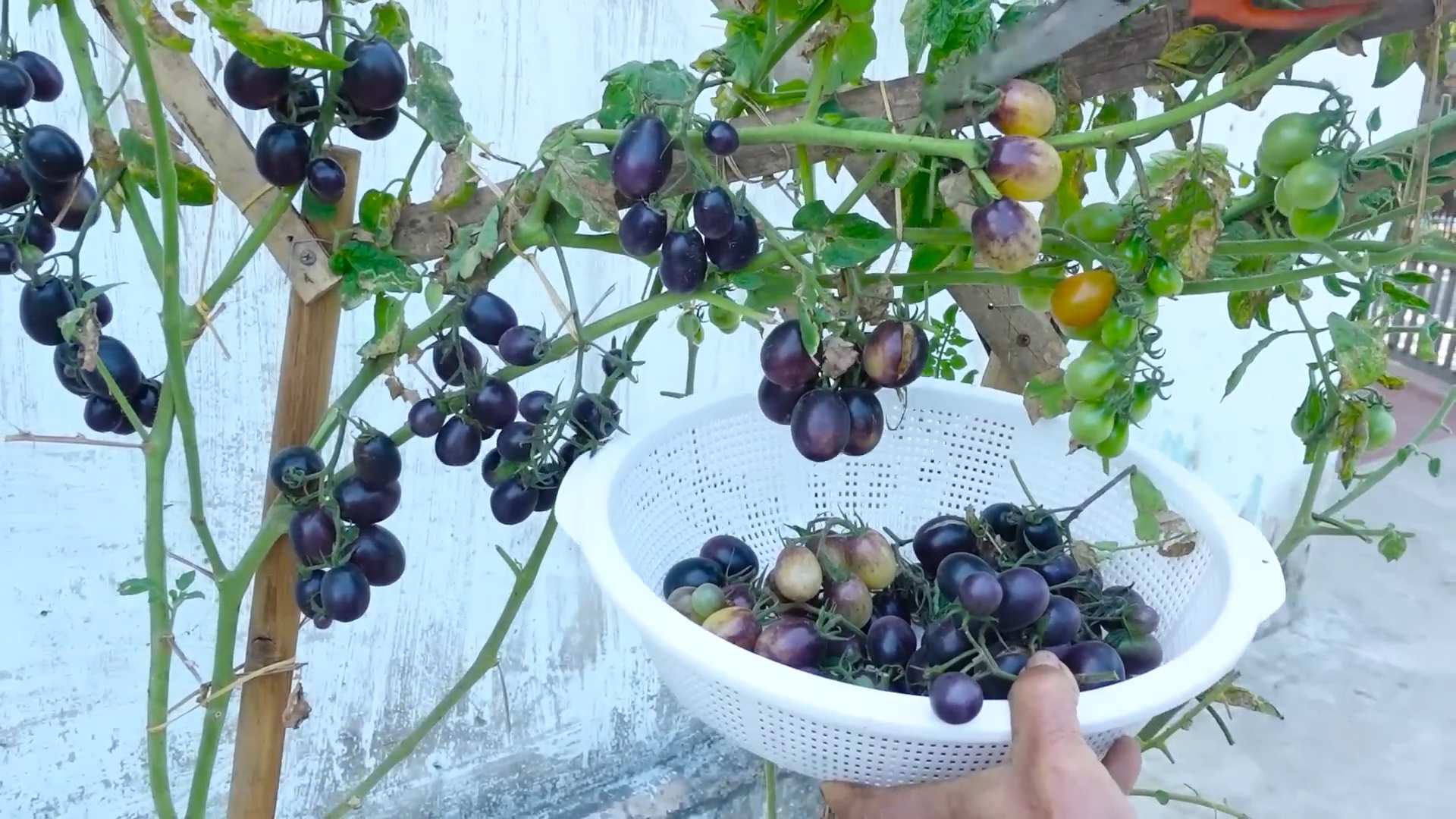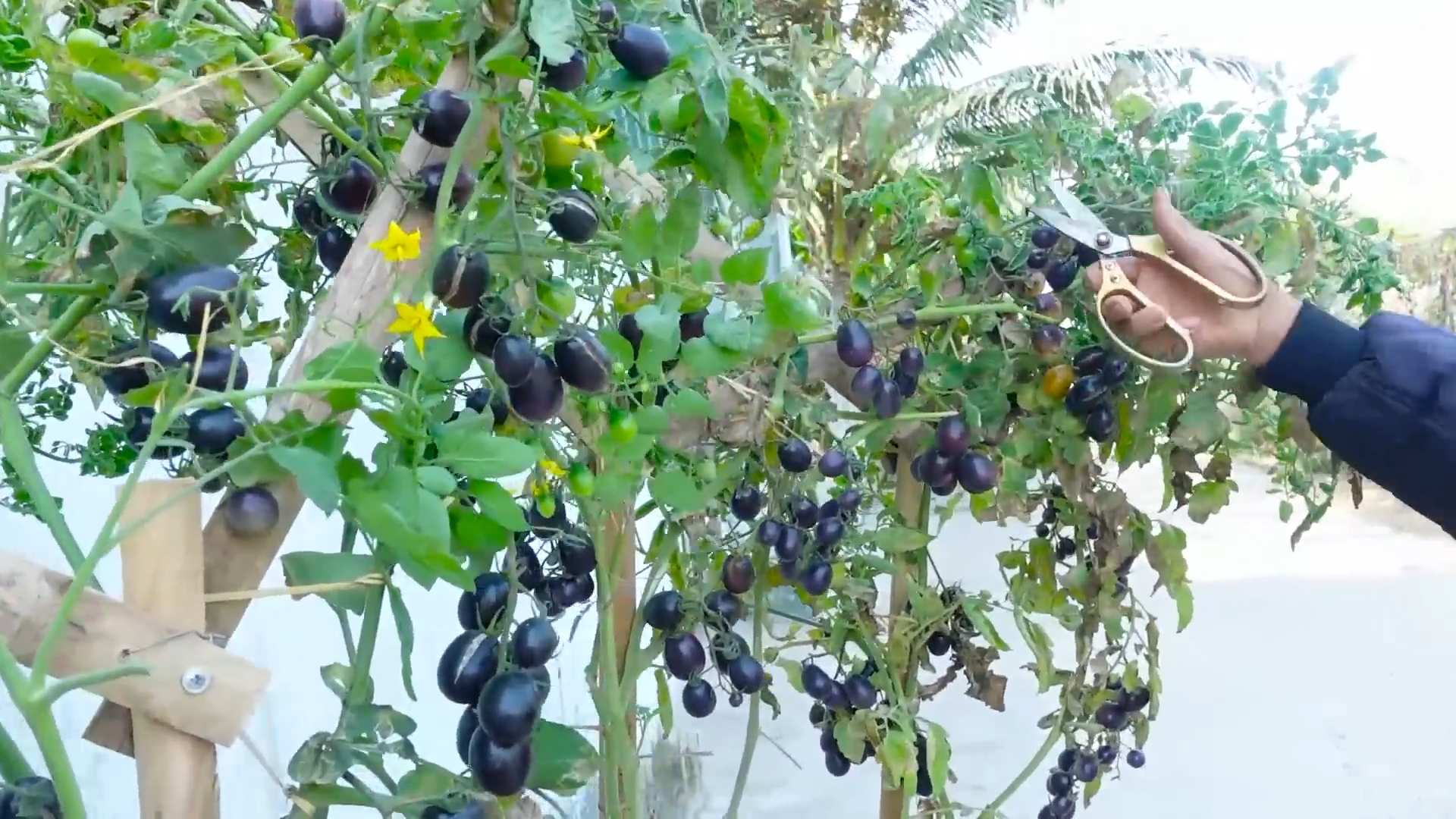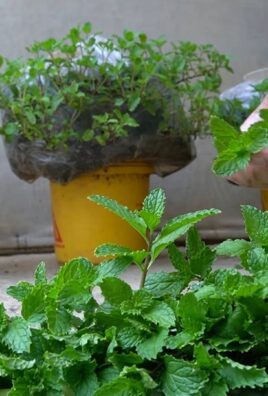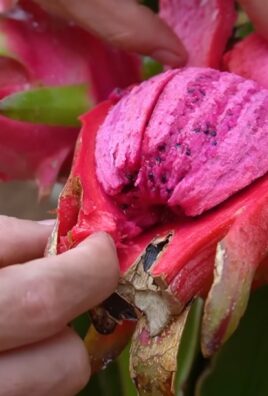Tomatoes in Pots: Imagine plucking a sun-ripened, juicy tomato straight from your own patio, the taste exploding with freshness unlike anything you’ve ever bought at the store. Sounds dreamy, right? Well, it doesn’t have to be just a dream! For centuries, growing food in containers has been a resourceful practice, dating back to ancient civilizations who utilized pots to cultivate herbs and vegetables in limited spaces. Today, this tradition thrives, especially for us urban dwellers or those with small gardens.
But let’s be honest, sometimes getting those vibrant, flavorful tomatoes can feel like a real challenge. Maybe your plants are struggling, or you’re just not sure where to start. That’s where these DIY tricks and hacks come in! I’m going to share some simple, yet incredibly effective, methods to help you master the art of growing tomatoes in pots.
Why do you need these tricks? Because everyone deserves the joy of homegrown goodness! Plus, growing your own food is not only rewarding but also a fantastic way to save money, reduce your carbon footprint, and ensure you’re eating healthy, pesticide-free produce. So, let’s dive in and unlock the secrets to a bountiful tomato harvest, right on your doorstep!

Growing Tomatoes in Pots: A Comprehensive DIY Guide
Hey there, fellow gardening enthusiasts! I’m super excited to share my tried-and-true method for growing juicy, delicious tomatoes right in pots. Whether you have a sprawling backyard or just a sunny balcony, this guide will walk you through every step, from choosing the right variety to harvesting your bountiful crop. Let’s get our hands dirty!
Choosing the Right Tomato Variety
Not all tomatoes are created equal, especially when it comes to container gardening. You’ll want to select varieties that are compact and well-suited for smaller spaces. Here’s a breakdown:
* **Determinate Tomatoes:** These are bush-type tomatoes that grow to a specific size and produce all their fruit at once. They’re perfect for canning or making large batches of sauce. Think Roma, Celebrity, and Patio.
* **Indeterminate Tomatoes:** These are vining tomatoes that keep growing and producing fruit throughout the season. They’ll need staking or caging, but they offer a continuous harvest. Popular choices include Cherry, Grape, Beefsteak (smaller varieties), and Early Girl.
* **Dwarf Tomatoes:** These are specifically bred for containers and small gardens. They stay very compact and produce smaller fruits. Look for varieties like Tiny Tim, Venus, and Patio Princess.
My personal recommendation? Start with a determinate variety like Roma or Celebrity for your first time. They’re relatively easy to manage and produce a good yield. Cherry tomatoes are also a great option for beginners!
Gathering Your Supplies
Before we dive into planting, let’s make sure we have everything we need. Here’s a checklist:
* **Pots:** Choose pots that are at least 18 inches in diameter and 18 inches deep. Larger is always better! Fabric pots are also a great option as they allow for better drainage and aeration.
* **Potting Mix:** Don’t use garden soil! It’s too heavy and compacts easily. Opt for a high-quality potting mix specifically formulated for containers. I like to use a mix that contains peat moss, perlite, and vermiculite.
* **Tomato Seedlings or Seeds:** You can start your tomatoes from seed indoors 6-8 weeks before the last frost, or you can purchase seedlings from a local nursery.
* **Tomato Cage or Stakes:** Indeterminate varieties will need support to prevent them from sprawling.
* **Fertilizer:** Use a balanced fertilizer specifically formulated for tomatoes. Look for one with an N-P-K ratio of around 5-10-5.
* **Watering Can or Hose:** Essential for keeping your plants hydrated.
* **Gardening Gloves:** To protect your hands.
* **Trowel:** For planting and transplanting.
* **Mulch:** To help retain moisture and suppress weeds. Straw, wood chips, or shredded bark work well.
Step-by-Step Planting Guide
Alright, let’s get planting!
1. **Prepare Your Pots:** Fill your pots with potting mix, leaving about 2-3 inches of space at the top.
2. **Planting Seedlings:** If you’re using seedlings, gently remove them from their containers. Loosen the roots slightly with your fingers. Dig a hole in the potting mix that’s large enough to accommodate the root ball. Place the seedling in the hole and backfill with potting mix.
3. **Planting Seeds:** If you’re starting from seed, sow 2-3 seeds per pot, about 1/4 inch deep. Cover with potting mix and gently water. Once the seedlings emerge, thin them out to one plant per pot.
4. **Water Thoroughly:** After planting, water your tomatoes thoroughly until water drains out of the bottom of the pot.
5. **Add Support:** If you’re growing an indeterminate variety, install a tomato cage or stakes at this point. This will help support the plant as it grows.
6. **Mulch:** Add a layer of mulch around the base of the plant to help retain moisture and suppress weeds.
7. **Location, Location, Location:** Place your pots in a location that receives at least 6-8 hours of sunlight per day. Tomatoes need plenty of sun to thrive.
Caring for Your Tomato Plants
Now that your tomatoes are planted, it’s time to provide them with the care they need to flourish.
* **Watering:** Water your tomatoes regularly, especially during hot, dry weather. The soil should be consistently moist, but not soggy. Check the soil moisture by sticking your finger into the soil. If the top inch feels dry, it’s time to water.
* **Fertilizing:** Fertilize your tomatoes every 2-3 weeks with a balanced tomato fertilizer. Follow the instructions on the fertilizer package.
* **Pruning:** Pruning is important for indeterminate tomato varieties. Remove suckers (the small shoots that grow between the main stem and the branches) to encourage fruit production. Determinate varieties generally don’t need pruning.
* **Pest and Disease Control:** Keep an eye out for pests and diseases. Common tomato pests include aphids, tomato hornworms, and whiteflies. Common diseases include early blight, late blight, and blossom end rot. Treat any problems promptly with appropriate organic or chemical controls.
* **Sun Scald Prevention:** During periods of intense heat, your tomatoes may be susceptible to sun scald. This is when the fruit develops white or yellow patches on the side facing the sun. To prevent sun scald, provide some shade during the hottest part of the day. You can use shade cloth or move the pots to a shadier location.
* **Pollination:** While tomatoes are self-pollinating, sometimes they need a little help, especially if you’re growing them indoors or in a sheltered location. Gently shake the plants or use a small brush to transfer pollen from one flower to another.
Troubleshooting Common Problems
Even with the best care, you might encounter some problems along the way. Here are a few common issues and how to address them:
* **Blossom End Rot:** This is caused by a calcium deficiency. The bottom of the tomato develops a dark, leathery spot. To prevent blossom end rot, ensure your soil is rich in calcium and water your plants consistently. You can also add calcium supplements to the soil.
* **Yellowing Leaves:** Yellowing leaves can be caused by a variety of factors, including overwatering, underwatering, nutrient deficiencies, and disease. Check the soil moisture and adjust your watering accordingly. Fertilize your plants regularly and treat any diseases promptly.
* **Lack of Fruit:** If your tomato plants are not producing fruit, it could be due to a lack of pollination, insufficient sunlight, or extreme temperatures. Ensure your plants are getting enough sunlight and help with pollination if necessary.
Harvesting Your Tomatoes
The moment we’ve all been waiting for! Harvesting your tomatoes is the most rewarding part of the process.
* **When to Harvest:** Tomatoes are ready to harvest when they are fully colored and slightly soft to the touch. The color will depend on the variety you’re growing.
* **How to Harvest:** Gently twist the tomato off the vine. Be careful not to damage the plant.
* **Storing Your Tomatoes:** Store your tomatoes at room temperature. Refrigerating them can affect their flavor and texture.
Extending the Growing Season
Want to keep enjoying fresh tomatoes even as the weather cools down? Here are a few tips for extending the growing season:
* **Cold Frames:** Use cold frames to protect your plants from frost.
* **Row Covers:** Cover your plants with row covers to provide extra warmth.
* **Move Pots Indoors:** If you have a sunny window, you can move your pots indoors to continue growing your tomatoes.
Additional Tips and Tricks
* **Companion Planting:** Plant basil near your tomatoes. Basil is said to improve the flavor of tomatoes and repel pests.
* **Epsom Salts:** Add Epsom salts to the soil to provide magnesium, which can help with fruit production.
* **Rotate Your Crops:** Don’t plant tomatoes in the same spot year after year. Rotate your crops to prevent soilborne diseases.
* **Heirloom Varieties:** Consider growing heirloom tomato varieties for unique flavors and colors.
Growing tomatoes in pots is a fun and rewarding experience. With a little care and attention, you can enjoy fresh, delicious tomatoes all season long. Happy gardening!

Conclusion
So, there you have it! Growing your own tomatoes in pots is not just a gardening trend; it’s a gateway to incredibly flavorful, sun-ripened goodness right at your fingertips. We’ve explored the simple steps, from selecting the right pot and soil to providing the essential sunlight and support. But why is this DIY trick a must-try? Because it empowers you to control the entire process, ensuring you get the healthiest, most delicious tomatoes imaginable, free from harmful pesticides and bursting with homegrown flavor.
Imagine biting into a juicy, red tomato, still warm from the sun, knowing you nurtured it from a tiny seedling. That’s the magic of growing your own. Plus, it’s incredibly rewarding to watch your plants thrive and produce a bountiful harvest.
But the fun doesn’t stop there! Feel free to experiment with different tomato varieties. Cherry tomatoes are perfect for snacking, while Roma tomatoes are ideal for sauces. Consider adding companion plants like basil or marigolds to your pots. Basil not only enhances the flavor of your tomatoes but also helps deter pests, while marigolds add a splash of color and attract beneficial insects. You can also try different potting mixes to see which one works best for your specific environment. Some gardeners swear by adding compost tea to their watering routine for an extra boost of nutrients.
For those with limited space, consider using hanging baskets for smaller tomato varieties. This is a great way to maximize your growing area and add a touch of beauty to your balcony or patio. You can also explore vertical gardening techniques, such as using trellises or tomato cages, to support your plants and keep them off the ground.
Don’t be afraid to get creative and personalize your tomato-growing experience. The most important thing is to have fun and enjoy the process.
We are confident that with a little effort and these simple tips, you’ll be enjoying a delicious harvest of homegrown tomatoes in no time. Remember, even if you’ve never gardened before, growing tomatoes in pots is a fantastic way to start. It’s a relatively low-maintenance project that yields incredibly satisfying results.
So, what are you waiting for? Grab a pot, some soil, and a tomato seedling, and get started today! We encourage you to try this DIY trick and share your experience with us. Post photos of your tomato plants on social media using #HomegrownTomatoes and let us know what varieties you’re growing and any tips you’ve discovered along the way. We can’t wait to see your success! Let’s create a community of tomato enthusiasts, sharing our knowledge and passion for homegrown goodness. Happy gardening!
Frequently Asked Questions (FAQ)
What is the best size pot for growing tomatoes?
The ideal pot size for growing tomatoes depends on the variety. For determinate (bush) tomatoes, a 10-15 gallon pot is generally sufficient. Indeterminate (vining) tomatoes, which grow much larger, require at least a 20-25 gallon pot to accommodate their extensive root systems. Using a pot that is too small can stunt the plant’s growth and reduce its yield. Ensure the pot has adequate drainage holes to prevent waterlogging.
What type of soil should I use for growing tomatoes in pots?
Avoid using garden soil in pots, as it can become compacted and doesn’t drain well. Instead, opt for a high-quality potting mix specifically formulated for containers. Look for a mix that contains ingredients like peat moss, perlite, and vermiculite, which provide good drainage and aeration. You can also amend the potting mix with compost or other organic matter to improve its fertility. A slightly acidic soil pH of around 6.0-6.8 is ideal for tomatoes.
How often should I water my tomato plants in pots?
Watering frequency depends on factors like weather, pot size, and plant size. Generally, you should water your tomato plants deeply whenever the top inch of soil feels dry to the touch. During hot, sunny weather, you may need to water them daily. Avoid overwatering, as this can lead to root rot. Use a watering can or hose to water the base of the plant, avoiding wetting the foliage, which can encourage fungal diseases.
How much sunlight do tomatoes need?
Tomatoes need at least 6-8 hours of direct sunlight per day to thrive. Choose a location for your pots that receives plenty of sunlight throughout the day. If you live in a particularly hot climate, you may need to provide some afternoon shade to prevent the plants from overheating. If you don’t have access to enough natural sunlight, you can supplement with grow lights.
Do I need to fertilize my tomato plants in pots?
Yes, tomatoes are heavy feeders and require regular fertilization to produce a bountiful harvest. Start fertilizing your plants a few weeks after transplanting them into their pots. Use a balanced fertilizer specifically formulated for tomatoes, following the instructions on the label. You can also use organic fertilizers like compost tea or fish emulsion. Fertilize every 2-3 weeks throughout the growing season.
How do I support my tomato plants in pots?
Indeterminate tomato varieties, in particular, require support to prevent them from sprawling and breaking under the weight of their fruit. Use tomato cages, stakes, or trellises to provide support. Install the support structure when you transplant the seedlings into their pots to avoid damaging the roots later on. As the plants grow, tie the stems to the support structure using soft twine or plant ties.
What are some common pests and diseases that affect tomatoes, and how can I prevent them?
Common pests that affect tomatoes include aphids, whiteflies, and tomato hornworms. You can control these pests by handpicking them off the plants, using insecticidal soap, or introducing beneficial insects like ladybugs. Common diseases include early blight, late blight, and blossom end rot. Prevent these diseases by providing good air circulation, avoiding overhead watering, and using disease-resistant tomato varieties. Blossom end rot is often caused by calcium deficiency, so ensure your soil is rich in calcium or amend it with calcium supplements.
Can I grow tomatoes indoors?
Yes, you can grow tomatoes indoors, but it requires more effort than growing them outdoors. You’ll need to provide adequate light, either through a sunny window or with grow lights. You’ll also need to pollinate the flowers manually, as there won’t be any bees or other pollinators indoors. Choose a compact tomato variety that is well-suited for indoor growing.
How long does it take for tomatoes to ripen?
The time it takes for tomatoes to ripen depends on the variety and the growing conditions. Generally, it takes 60-85 days from transplanting the seedlings to harvesting ripe tomatoes. The fruits will turn from green to red (or yellow, orange, or purple, depending on the variety) when they are ripe. Gently squeeze the tomato; it should be slightly soft to the touch.
What can I do with my homegrown tomatoes?
The possibilities are endless! You can eat them fresh in salads, sandwiches, or as a snack. You can also use them to make sauces, soups, salsas, and other dishes. Preserve your harvest by canning, freezing, or drying your tomatoes. Share your bounty with friends and neighbors!




Leave a Comment